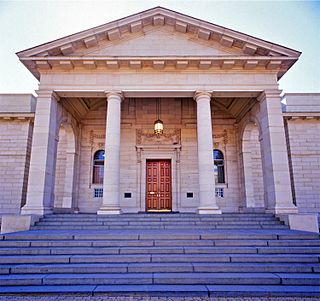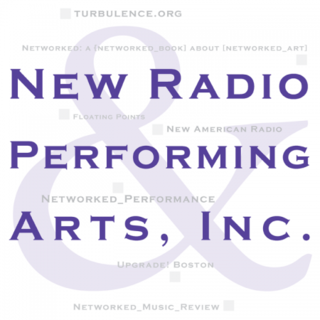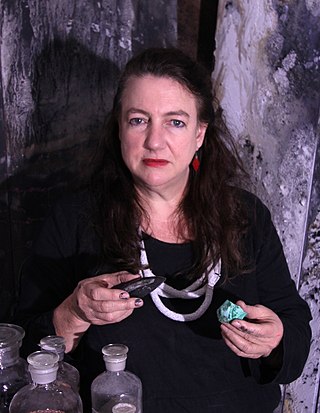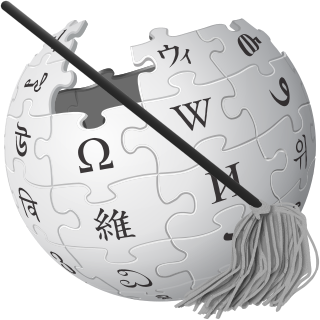Career
Stern graduated with a degree in Textiles and Apparel Design from Cornell University in Ithaca, New York in 1999, and went on to study at the Interactive Telecommunications Program at New York University, graduating in 2001. He later taught digital art at the University of the Witwatersrand, while also practicing as an artist, in Johannesburg, South Africa from 2001 - 2006. He holds a PhD from Trinity College in Dublin, Ireland, where he wrote a dissertation on interactive art and embodiment. [1]
Stern's early study of fashion design, slam poetry and music led to his interest in the relationships between the body and text, and eventually to that of broadly interpreted notions of performance and performativity, especially in relation to the body and embodiment. [4] He states that his interactive work treats "the body and art as cooperative sites of potential resistance," seeing them as mutable entities that "per-form" themselves in relation to their environments, rather than being extant and "pre-formed." [1] Stern's other work often attempts to bring his ideas around performance, embodiment, time and interactivity to more traditional forms like sculpture, drawing and print by combining them with digital and networked media. [5]
Work
Stern's interactive art is centered around bodily provocations, often asking his viewers to "perform" — whether publicly or privately. His pieces attempt to "get people to move in ways they normally wouldn't," and accent said movements in relation to their surroundings. [6] His installation, enter:hektor, for example, asks participants to chase projected words with their arms and bodies in order to trigger spoken word in the space, and his subsequent piece, stuttering, floods the interaction area with too many trigger points, pushing its viewers "not to interact." [4]
His early (2005) and ongoing "Compressionist" prints, conversely, ask Stern himself to move in ways he normally wouldn't. [6] These images are made through performances with scanners, Stern often tying or rigging a flat-bed to his own body, then traversing the landscape — avowedly referencing Impressionism and Abstract Expressionism. [7] These are colored in Photoshop, then printed on metallic paper and/or transformed into hand-made prints, using more traditional techniques. [8]
Stern's video art tends to be in a performative writing style, where he often plays out characters he has created, or uses found footage from films, to explore the fragility of language. [9] He has also worked on collaborative multimedia performances that explore similar issues, usually with more explicit political messages, such as challenging the discourse surrounding HIV/AIDS in South Africa. [10]
Stern's interventionist projects are always site-specific, playful and political. In his Wireframe Series, for example, he has volunteers from the streets of Dubrovnik, Croatia or Johannesburg, South Africa, physically erect temporary, 3D architectural structures made of rope. Each of these custom "public spaces" are "activated" only through their "contact with people," and take on different meanings in each context. [11] And in Doin' my Part to Lighten the Load, Stern challenges power relations between artists and critics, and black and white — as well as electrical "power structures" — by convincing South African arts writer, and editor of Art South Africa magazine, Sean O'Toole, to give up electricity for 24 hours; Stern hired workers off the street to follow O'Toole around his apartment with hand-crank generators and bulbs for the evening. [12]
Stern's "Distill Life" works, multimedia collaborations with Milwaukee artist Jessica Meuninck-Ganger that began in 2009, combine various forms of traditional printmaking with video and machinima. Here the artists "mount translucent prints and drawings on top of video monitors, which appear to bring moving images to life on paper." [13] According to Chris Roper of South Africa's Mail and Guardian, "The work is funny, pretty and accessible, but it’s also complicated, surprising, exceedingly well crafted and rewards a long-term relationship." [14] The works pay homage to and cite a number of artists, including Diego Velázquez, [15] Katsushika Hokusai, [16] Eadweard Muybridge, Claude Monet, Jan van Eyck, William Kentridge, Utagawa Hiroshige and others. [17]
And Stern's Second Life-based mixed reality art work explores "the juxtaposition of old and new media and illuminates the possibilities and limitations of both." [18] "Given Time," for example, enacts a permanent "connection between two simulated people staring wordlessly at each other across real space." [19] According to John Mitchell, Stern uses "Second Life as a medium much like oil paint or marble, hand-drawing two Second Life avatars and pulling them from out of their universe and into ours. In the gallery, they exist on two large screens facing each other, and the viewer may only encounter them by walking between the screens." [20] The piece directly references both the book "Given Time," by Jacques Derrida, [21] and the art work "Untitled (Perfect Lovers)," by Félix González-Torres. [18]
Stern and Creative Commons
Stern is an advocate of Creative Commons (CC), with his blog, and many of his pieces, under CC or GPL. He has been a contributing member of iCommons since its inception, and was an artist in residence with them in 2006 and 2007, the second year of which he ran the program. [6] He believes that "as many people as possible need to see art and talk about it" because it "always brings... value" to "the cultural sphere"; he uses CC as a "tactic for the most effective art work, and with the recognition that this will only bring more value — both culturally and monetarily — to [his] work more generally, whether it's for sale or not." [5]
Wikipedia Art
On February 14, 2009, Stern and Scott Kildall created a Wikipedia article called "Wikipedia Art", which sought to "invite performative utterances in order to change" what content was acceptable to include in the article itself. It that was simultaneously a self-referential performance art piece called Wikipedia Art. Although the creators encouraged editors to strictly follow Wikipedia guidelines in editing the page, [22] Wikipedia editors determined its intent was nonetheless in violation of site rules, and it was deleted within 15 hours of its initial posting. The resulting controversy received national coverage, including an article in The Wall Street Journal . [23] The Wikimedia Foundation later claimed Stern and Kildall had infringed on the Wikipedia trademark with their own website, wikipediaart.org. The artists publicly released a letter they received in March 2009 from a law firm requesting that they turn over their domain name to Wikipedia. [24] Mike Godwin, then the foundation's legal council, later stated that they would not pursue any further legal action. [25] Mary Louise Schumacher of The Milwaukee Journal Sentinel compared the incident to the "outrage inspired by Marcel Duchamp's urinal or Andy Warhol's Brillo Boxes." [26] Yale research fellow Claire Gordon called the article an example of the "feedback loop" of "Wikipedia’s totalizing claims to knowledge" in a 2011 Huffington Post report. [27]
Wikipedia Art has since been included in the Internet Pavilion of the Venice Biennale for 2009. [28] In 2011 it appeared in a revised form at the Transmediale festival in Berlin, [29] where it was an award finalist. [2]
In 2012, Stern and Kildall again partnered on a project called "Tweets In Space", inviting participants to submit tweets to be transmitted to the planet GJ 667Cc, whose conditions scientists believe may be capable of supporting life. [30] The transmission is scheduled to take place in September 2012 at the International Symposium on Electronic Art in Albuquerque, New Mexico. [31] Stern and Kildall used RocketHub to fundraise the money needed to access a transmitter capable of reaching the planet. In addition, code developed for the project is planned for release to open source. [32] According to Stern and Kildall, the goal of "Tweets In Space" is to activate "a potent conversation about communication and life that traverses beyond our borders or understanding." [33]
Exhibitions
In 2003 and 2004, Stern exhibited at the now defunct Brett Kebble Art Awards, South Africa's largest contemporary art competition at the time. Both years, he won prizes for interactive installations, and is credited with being "at least partly responsible for opening space within that national art event for interactive or New Media work generally." [1] From December 2004 to January 2005, Stern held his first major solo exhibition, The Storytellers, at the Johannesburg Art Gallery, South Africa's largest, internationally recognized publicly funded museum. [34]
In 2006 and 2007, Stern held two solo exhibitions of his "Compressionist" prints in South Africa. The series premiered in "Time and Seeing" at Pretoria's experimental Outlet Gallery, and a much larger body of work, including digital and traditional prints, opened as 'Call and Response' at Johannesburg's Art on Paper Gallery (now called Gallery AOP). [8] On January 31, 2008, Ten Cubed Gallery in Second Life was launched. For its inaugural exhibition, Crossing the Void II, owner and curator Haydn Shaughnessy selected five artists working in and with modern technologies: Stern along with Chris Ashley from Oakland, CA, Jon Coffelt from New York, NY, Claire Keating from Cork, Ireland and Scott Kildall from San Francisco, CA. [35]
In 2010, Stern's Distill Life collaborations with Jessica Meuninck-Ganger were presented as part of the "Passing Between" solo exhibition at Gallery AOP in Johannesburg, [17] as well as solo exhibitions at the Museum of Wisconsin Art and Elaine Erickson Gallery in Wisconsin. [13] Given Time launched as part of a solo exhibition at Greylocks Arts in March 2010. The show, which also exhibited "Distill Life" works, was curated by Jo-Anne Green of Turbulence.org. [18] Falling Still, a collaboration with Yevgeniya Kaganovich," premiered in the Art History Gallery at the University of Wisconsin in December 2010. [36]
In June 2011 Stern again worked with Kaganovich on "Strange Vegetation", a project involving "breathing" latex sculptures that react to changes in light and temperature. The installation was displayed at the Villa Terrace Decorative Arts Museum in Milwaukee, Wisconsin. [37] [38] In August of the same year Stern's exhibit "Giverny of the Midwest" opened at Gallery AOP in Johannesburg. [39] The exhibit, inspired by Claude Monet's series Water Lilies, featured images of a pond in Indiana taken with a HP scanner while Stern walked through the pond. [40] In October 2011, Stern and Jessica Meuninck-Ganger's collaborative project "13 Views of a Journey" opened at the Haggerty Museum of Art on the Marquette University campus featuring a blend of print and video imagery. [41]
Throughout his career, Stern's work has also been shown at the Venice Biennale, Museum of Contemporary Art, Sydney, South African National Gallery, Johannesburg Art Gallery, International Print Center New York, Herbert F. Johnson Museum of Art, Pretoria Art Museum, John Michael Kohler Arts Center, Milwaukee Art Museum, Museum of Wisconsin Art, Inter-Society for the Electronic Arts and in festivals and performances all over the world.

William Kentridge is a South African artist best known for his prints, drawings, and animated films, especially noted for a sequence of hand-drawn animated films he produced during the 1990s. The latter are constructed by filming a drawing, making erasures and changes, and filming it again. He continues this process meticulously, giving each change to the drawing a quarter of a second to two seconds' screen time. A single drawing will be altered and filmed this way until the end of a scene. These palimpsest-like drawings are later displayed along with the films as finished pieces of art.
Brett Murray is a South African artist mostly known for his steel and mixed media wall sculptures. He was born in Pretoria, South Africa. Murray has a master's degree in fine art from the Michaelis School of Fine Art, 1989. Referred to by critic Brenda Atkinson as "the dark prince of South African pop (art)", Murray is one of the country's most popular artists, often using easily recognisable media images with the addition of a subversive and bitterly funny twist. Murray's work addresses the wars of the cultures, the clash between Afrocentrism and Eurocentrism, the old and the new South Africas. "With my work I hope to critically entertain. Through satirical and tragic reflections on South Africa, I hope to shift people's perspectives and change people's minds, indulgent, arrogant and pretentious as this might sound," he says. More recently, his work has explored his own personal experiences and identity. Murray was also the founder of the sculpture department at Stellenbosch University.

The Johannesburg Art Gallery is an art gallery in Joubert Park in the city centre of Johannesburg, South Africa. It is the largest gallery on the continent with a collection that is larger than that of the Iziko South African National Gallery in Cape Town.

Scott Kildall is an American conceptual artist working with new technologies in a variety of media including video art, prints, sculpture and performance art. Kildall works broadly with virtual worlds and in the net.art movement. His work centers on repurposing technology and repackaging information from the public realm into art. He often invites others to participate in the work.

The Pretoria Art Museum is an art gallery located in Arcadia, Pretoria in South Africa. The museum in Arcadia Park occupies an entire city block bounded by Park, Wessels, Schoeman and Johann Streets.

New Radio and Performing Arts, Inc. (NRPA), and its satellite project Turbulence.org, was an American organization that commissioned and archived new and experimental radio art, sound art, net art and mixed reality art. It was founded in 1981 by Helen Thorington. In 2003, NRPA opened an office in Boston, Massachusetts. The organization closed in December 2017.
Jessica Meuninck–Ganger is an American printmaker, educator, and book artist. She is based in Milwaukee.
Gary Schneider is a South African-born American photographer known for his portraiture and self-portraits. According to the John Simon Guggenheim Memorial Foundation, which awarded him a Guggenheim Fellowship in 2013, his "early work in painting, performance, and film remain integral to his explorations of portraiture. He strives to marry art and science, identity and obscurity, figuration and abstraction, the carnal and the spiritual."

Diane Victor, is a South African artist and print maker, known for her satirical and social commentary of contemporary South African politics.

Diana Page is a painter, performance and installation artist originally from South Africa but currently residing in Istanbul, Turkey. Exploring experiences of traveling back and forth between these two homes, Page's artwork concerns ideas of globalization and nomadic lifestyle. Through painting, drawing, performance, installation, and video, Page investigates the urban environments she inhabits as an emotional as well as physical setting.
Sanell Aggenbach is a South African artist living and working in Woodstock, Cape Town. Using painting, printmaking, and sculpture, her work addresses the relationship between history and private narratives, with a sense of ambiguity. Her work also explores the processes of nostalgia and historical myth-making, often incorporating the playful, disarming, and absurd to draw the viewer into discussions of darker subjects. She has a unique style of combining traditional painting techniques with sculptural elements, as well as typically feminine crafts such as sewing and tapestry.

Marco Cianfanelli is a South African artist who has been involved in a wide range of projects involving art, architecture and public spaces. Cianfanelli combines computer-generated, data-driven applications with human, expressive, gestural acts to create tension in his work. Cianfanelli is one of a handful of South African artists whose work successfully spans the public and domestic sphere. He began his career painting landscapes and continues to be concerned with romanticized space and that which is marginalized through the very act of romanticizing. Cianfanelli's slick, pared-down, iconographic recent works are intricately linked with the complexity of loving South Africa.

Kathryn Smith is a South African artist, curator, and researcher. She works on curatorial projects, scholarly research, and studio practices, while her art deals with uncertainty, risk, and experimentation. She works in Cape Town and Stellenbosch. Her works have been exhibited and collected in South Africa and elsewhere. In 2006, she was appointed senior lecturer in the Department of Visual Arts at the University of Stellenbosch and head of the Fine Arts Studio Practice program. She took a break in 2012/2013 to read for an MSc at the University of Dundee.

Daniel Maggs is a South African architect and artist living and working in Cape Town. His latest project, ShackRise, exhibited at the Spier Contemporary 2010, depicts a scenario in which an abandoned high-rise development is taken over by squatters.
Michael Meyersfeld is a fine art photographer living and working in Johannesburg, South Africa. Meyersfeld works with both fine art and advertising photography.

Jeannette Unite is a South African artist who has collected oxides, metal salts and residues from mines, heritage and industrial sites to develop paint, pastel and glass recipes for her large scale artworks that reflect on the mining and industrial sites where humanity's contemporary world is manufactured.
Jacob van Schalkwyk is a South African visual artist and writer.
Sam Nhlengethwa is a South African creative collage artist and the co-founder of Bag Factory Artists' Studio.

Volunteer editors of Wikipedia delete articles from the online encyclopedia regularly, following processes that have been formulated by the site's community over time. The most common route is the outright deletion of articles that clearly violate the rules of the website. Other mechanisms include an intermediate collaborative process that bypasses a complete discussion, and a whole debate at the dedicated forum called Articles for deletion (AfD). As a technical action, deletion can only be done by a subset of editors assigned particular specialized privileges by the community, called administrators. An omission that has been carried out can be contested by appeal to the deleting administrator or on another discussion board called Deletion review (DRV).
Jo-Anne Green is a printmaker, visual artist, artist, arts administrator, writer, and educator who lives in Boston, Massachusetts. She cofounded several non-profit organizations to support net art and experiments in digital and electronic literature and art.












